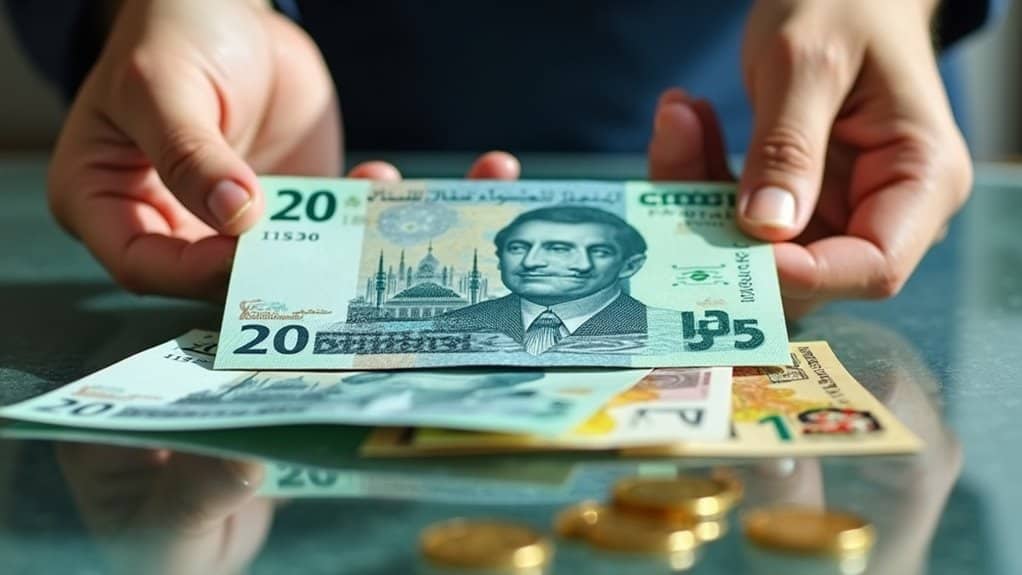The Kuwaiti Dinar tops global currency charts, valued around $3.25 USD per 1 KWD—its strength fundamentally minted from crude. Kuwait sits on colossal oil reserves, nearly 8% of the world’s total, fueling over 90% of state revenue with enviably low extraction costs. This immense wealth underpins rigorous monetary policy: the central bank pegs the dinar to an undisclosed basket of major currencies, avoiding speculative swings and leveraging a massive sovereign wealth fund exceeding $700 billion for stability. While this disciplined approach keeps the dinar stronger than Gulf peers like Bahrain’s $2.65 dinar, that high valuation can make non-oil exports pricier internationally. Yet it massively enhances import purchasing power, cushioning diversification efforts. Uncover how Kuwait keeps its currency king.
Historical Development of the Kuwaiti Dinar
When Kuwait introduced its national currency in 1961, replacing the Gulf Rupee at a precise 13⅓ Rupees to 1 Dinar, it signaled a bold move toward economic sovereignty.
You’ll trace the Kuwaiti Dinar’s historical development beginning with its foundation: initially pegged to the British Pound. That stability faced its gravest test during the Gulf War. Iraq invaded, voided the Kuwaiti Dinar entirely—imposing their currency instead—shattering local trust.
Liberation reset everything. By 2007, Kuwait abandoned singular pegs, adopting a diversified currency basket. Instantly, the KWD became the world’s highest-valued currency.
Watch its exchange rate swell from $2.80 at inception to over $3.25 now. For this oil-rich nation, such gains telegraph significant economic stability—rare and enviable.
Economic Drivers Supporting Dinar Strength
The Kuwaiti Dinar’s dominant position largely starts with massive oil reserves, holding nearly 8% of global supply—an economic engine generating huge export income.
This hydrocarbon wealth, paired with extraordinarily low production costs, catapults your GDP per capita among the world’s highest.
Wise fiscal policies channel these vast resources prudently, anchoring exceptional stability.
You observe the Kuwaiti Dinar pegged primarily to the US dollar within a currency basket, minimizing exchange rates volatility.
This structure, coupled with a massive sovereign wealth fund (over $700 billion!), solidifies market confidence, cementing its place among inherently strong currencies through disciplined reserves management and economic foresight.
The Role of Oil Wealth in Currency Value
Eight percent of global oil reserves actively establish Kuwait’s hydrocarbon jackpot as the Dinar’s bedrock. This oil wealth directly powers the Kuwaiti Dinar’s supremacy—significant oil exports generate over 90% of state revenue, translating into currency value that climbs with crude prices.
Low production costs ($7/barrel vs global $30+) further amplify profits, cementing a strong economic foundation.
You’ll see:
- Petroleum revenues instantly influence the high exchange rate when markets surge
- Prudent fiscal buffers use sovereign wealth to guarantee stability despite oil’s volatility
- The peg to the US dollar (within a basket) anchors confidence in global market exchanges
That’s how crude becomes convertible prestige.
Currency Management and Pegging Strategies
Though Kuwait’s oil wealth fuels its economic engine, it’s the Central Bank’s sophisticated currency management that locks in the Kuwaiti Dinar’s (KWD) position as the world’s highest-valued currency.
The Central Bank of Kuwait strategically pegs the KWD to a weighted basket of major currencies—USD, Euro, Pound Sterling, Yen—instead of a single peg. This subtle currency management shields it better from market swings.
Regulating currency inflow and outflow minimizes speculation, while the colossal $700 billion sovereign wealth fund provides unmatched stability, enhancing confidence.
Combined with vast oil reserves, this shrewd strategy underpins the strong exchange rate near 3.25 USD:1 KWD, directly supporting sustained economic growth.
Key Policy Frameworks Ensuring Stability
Ensuring the Kuwaiti Dinar remains the world’s strongest currency isn’t accidental; careful policy structures cement its stability through monetary discipline and wealth governance. You see stringent central bank controls governing currency flow, preventing destabilizing speculation.
Behind the currency strength lies a sturdy economy built on substantial oil wealth, shrewdly managed through a sovereign wealth fund exceeding $700 billion acting as a colossal financial buffer. Importantly, this economic power pairs with prudent fiscal policy—restrained government spending and adherence to oil production quotas—dampening inflation despite global volatility.
Sky-high GDP per capita signifies successful wealth distribution, supporting confidence and preserving the KWD’s dominant exchange rate.
Key pillars include:
- Strategic Currency Peg: Its undisclosed basket pegging offers flexibility while anchoring the exchange rate firmly.
- Fiscal Cooking Pot: Government keeps spending reasonable and oil taps controlled; this lid prevents the economy’s pressure cooker from overheating, ensuring low inflation.
- Massive Safety Net: That sovereign wealth fund? It’s the world-class disaster relief fund, ready to smooth out any economic bumps and defend currency strength.
Comparisons With Other Gulf Cooperation Council Currencies
While all GCC powerhouse currencies ride on oil wealth, the Kuwaiti Dinar consistently trades higher, pegged around $3.25 against the US dollar versus Bahrain’s $2.65 Dinar and Oman’s $2.60 Rial.
Though Kuwait, Bahrain, and Oman all utilize significant oil exports within the Gulf Cooperation Council to fuel strong economic power, the Kuwaiti Dinar’s superior nominal value reflects key strengths.
Kuwait boasts immense reserves (8% globally), translating to exceptionally low unemployment and high per capita wealth.
Consequently, Kuwait’s disciplined fiscal policies and remarkably low hydrocarbon production costs amplify its currency’s value—a subversive geopolitical punchline buried in spreadsheets.
Global Standing Among World Reserve Currencies
While the US dollar dominates global reserves at roughly 60% and the euro commands another 20%, you’ll notice the KWD doesn’t crack that top tier despite being the world’s strongest currency by value.
Its immense per-unit worth, anchored firmly by Kuwait’s 8% share of global oil reserves, doesn’t translate to widespread reserve status or challenge dollar supremacy internationally.
Frankly, the dinar operates as a regional powerhouse within the Gulf, its influence tethered tightly to petrochemical wealth even as the dollar fights off challengers across the entire reserve terrain.
Reserve Currency Dominance Comparison
Reserve currency premier league standings don’t necessarily match the currency strength rankings you see on exchange boards.
You’ll find the Kuwaiti Dinar topping nominal global value lists, yet it’s absent among dominant reserve currencies. The US Dollar anchors about 60% of global reserves, prized for liquidity rather than per-unit worth—unlike KWD, whose high value stems from volatile oil prices, not global demand.
- USD’s hegemony relies on unmatched economic power and liquidity networks, dwarfing Kuwait’s high GDP per capita influence.
- KWD thrives on oil riches but lacks scale for reserve roles; its strength doesn’t translate to institutional adoption.
- Reserve currencies must enable worldwide trade, whereas Kuwait’s dinar functions more as a niche high-value instrument.
This dichotomy proves nominal worth alone won’t crown reserve champions—universal utility eclipses localized strength.
US Dollar Supremacy Challenge
Holding roughly 60% of global reserves anchors the U.S. dollar as the world’s undisputed reserve currency, but storm clouds gather.
While the USD remains king, its grip loosens. Witness the Kuwaiti Dinar (KWD), emerging as the world’s strongest currency, trading near 3.25 USD.
This surprising resilience stems directly from immense oil wealth and a stable economy, offering a stark contrast to USD fluctuations fueling global anxieties.
Geopolitical tensions and economic shifts drive serious debates about reducing reliance on the USD.
Other currencies gain prominence; central banks increasingly broaden their global reserves, subtly challenging the idea of any single primary reserve currency.
Growing Economic Influence Trends
Surprisingly resilient currencies like the Kuwaiti Dinar—trading near 3.25 USD—showcase more than just high nominal value; they signal shifting tectonic plates in global financial power structures.
You witness its dominance anchored by vast oil reserves, a $700+ billion sovereign fund, and shrewd monetary policy. It’s not just about bragging rights; it’s hard economic infrastructure at work.
- Massive oil reserves guarantee strong export revenues, fueling the currency’s value and amplifying Kuwaiti purchasing power.
- A weighted-basket currency peg fortifies economic stability, making it a magnet for risk-averse global investors.
- That legendary sovereign wealth pile converts petrodollars into perpetual confidence, securing its rank among premier reserve currencies.
Whisper it: even giants envy this liquidity fortress.
Influence of Non-Hydrocarbon Sectors
Drilling down beyond Kuwait’s primary industry, you’ll see non-hydrocarbon sectors carving critical space within the economy, enhancing significant diversification efforts.
Finance anchors this shift, positioning Kuwait as a regional financial hub attracting substantial foreign investment through secure banks and regulation.
Look at real estate flourishing too: major urban and commercial projects elevate activity and jobs independent of crude.
Tourism gains momentum yearly, driven by government promotion of cultural landmarks aiming for better economic stability.
Ultimately, these expanding non-hydrocarbon sectors strategically reduce reliance on volatile global oil prices, supporting the Kuwaiti Dinar’s resilience. They cushion the economy when crude stumbles.
Mechanisms of Monetary Stability and Control
- The Mysterious Basket: The undisclosed currency peg formula allows nimble adjustments, sidestepping dependency on any single nation’s economic woes.
- Guardians at the Gate: The Central Bank enforces strict controls over money entering and leaving Kuwait, minimizing destabilizing speculation.
- The $700 Billion Safety Net: This immense sovereign fund provides unparalleled backing, buffering the KWD from oil price shocks and supporting global trust.
Impact of Currency Strength on International Trade
A strong currency like Kuwait’s Dinar (KWD ≈ 3.25 USD) makes your exports, think $70 barrels of Kuwaiti oil, more expensive globally—potentially deterring buyers and hurting non-oil trade competitiveness.
However, it drastically enhances your purchasing power for imports, letting you acquire foreign machinery or grain far cheaper relative to KWD.
This dual effect creates a fascinating tension: how do you manage the balance between oil’s windfall and broader trade health?
Export Competitiveness Challenges
Though boasting the world’s highest-valued currency, Kuwait’s prized dinar, hovering near 3.25 USD, directly inflates its exporters’ prices abroad. Your non-oil exports struggle in international trade, as that exchange rate adds a 25% premium over competitors’ goods.
Oil exports dominate—90% of Kuwait’s shipments—so crude price jumps elevate the dinar’s value higher via its rigid peg, crushing emerging sectors’ export competitiveness. Meanwhile, this currency stranglehold threatens economic growth by cementing trade imbalances.
- The Peg Problem: Kuwait’s 2007 basket peg locks your exchange rate, preventing devaluation to rescue exports during downturns.
- Oil’s Vicious Cycle: At $100/barrel, the currency soars, but your niche tech exports? Suddenly unaffordable in Southeast Asia.
- Non-Oil Crunch: Diversification efforts like high-end ceramics face brutal tariffs just to match rivals’ baseline pricing.
Import Affordability Benefits
Kuwait’s wallet gets unzipped far easier on the global market thanks to its commanding dinar, pegged near 3.25 USD – the world’s most respected currency.
Your purchasing power makes import affordability exceptional; you buy global goods and travel for comparatively less.
Critically for competitive businesses, the strong currency lets them acquire high-quality materials internationally, enhancing efficiency.
It subtly resists inflation on imports, shielding your economy’s internal costs.
This sustained Kuwaiti Dinar (KWD) value actively supports importing electronics and tech, encouraging an environment to build a more diverse economy alongside oil, while grabbing global gadgets gets cheaper.
Conclusion
A $3.27 exchange rate isn’t magic. Your preeminent Kuwaiti dinar, a globe-trotter among currencies, reflects massive reserves – oil barrels fundamentally fuelling its value and a $700+ billion sovereign fund acting like a shock absorber. Central bank mechanics, carefully calculating its peg to a hidden basket, guarantee continuity. Policy guardians vigilantly monitor inflation and diversification efforts. While uniquely strong, remember: its enviable perch remains fundamentally rooted in crude’s supremacy and controlled financial design. Call it hydrocarbon hegemony, perfected.


Leave a Reply